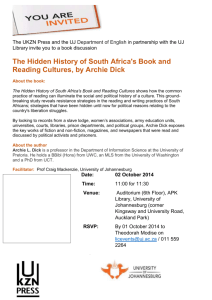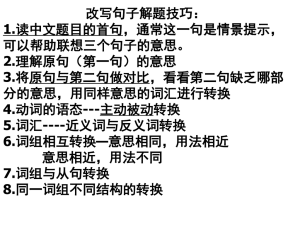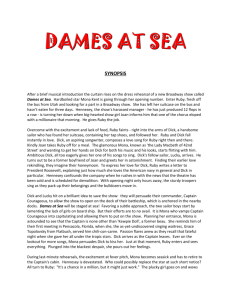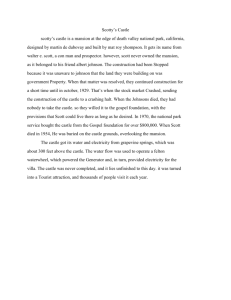on-Philip-K-Dick-High-Castle
advertisement
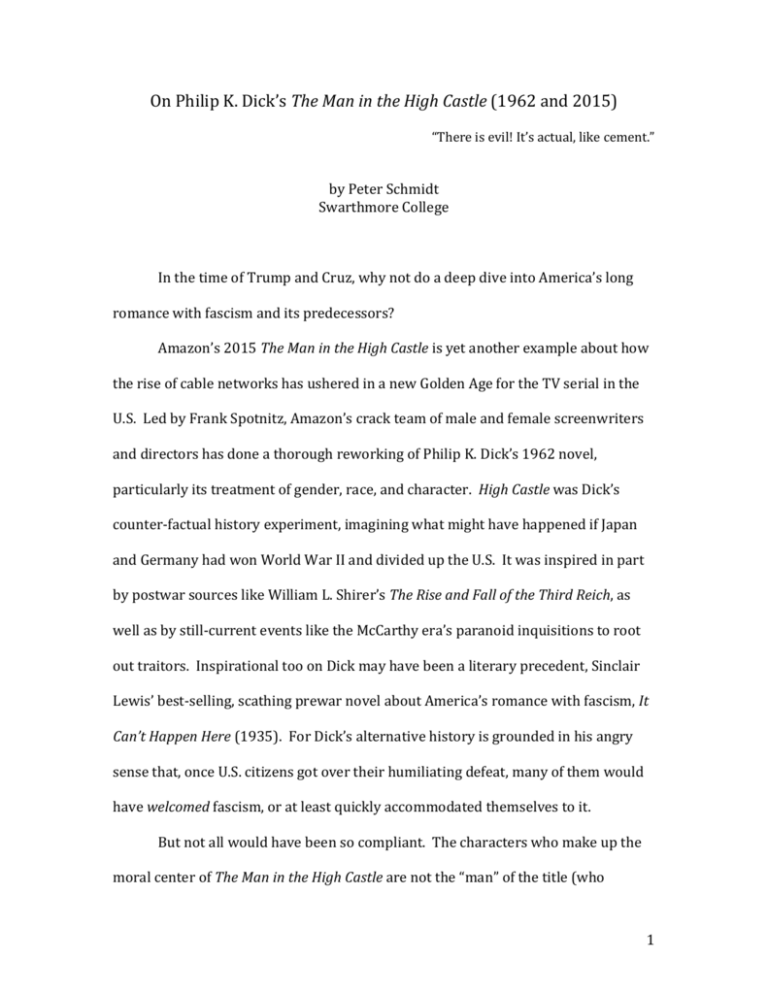
On Philip K. Dick’s The Man in the High Castle (1962 and 2015) “There is evil! It’s actual, like cement.” by Peter Schmidt Swarthmore College In the time of Trump and Cruz, why not do a deep dive into America’s long romance with fascism and its predecessors? Amazon’s 2015 The Man in the High Castle is yet another example about how the rise of cable networks has ushered in a new Golden Age for the TV serial in the U.S. Led by Frank Spotnitz, Amazon’s crack team of male and female screenwriters and directors has done a thorough reworking of Philip K. Dick’s 1962 novel, particularly its treatment of gender, race, and character. High Castle was Dick’s counter-factual history experiment, imagining what might have happened if Japan and Germany had won World War II and divided up the U.S. It was inspired in part by postwar sources like William L. Shirer’s The Rise and Fall of the Third Reich, as well as by still-current events like the McCarthy era’s paranoid inquisitions to root out traitors. Inspirational too on Dick may have been a literary precedent, Sinclair Lewis’ best-selling, scathing prewar novel about America’s romance with fascism, It Can’t Happen Here (1935). For Dick’s alternative history is grounded in his angry sense that, once U.S. citizens got over their humiliating defeat, many of them would have welcomed fascism, or at least quickly accommodated themselves to it. But not all would have been so compliant. The characters who make up the moral center of The Man in the High Castle are not the “man” of the title (who 1 appears only near the end), but a trio—Frank Frink, Juliana, and Mr. Tagomi. Tellingly, all three are more strongly realized in the TV series than in Dick’s sourcetext. They are beleaguered by fears and doubts, yet all reluctantly join the anti-Nazi resistance and have to suffer greatly because of it. In his novel Dick powerfully imagined the institutional and cultural shifts that Japanese rule would cause in the postwar U.S., including a fascination with collecting Americana like Colt pistols and other symbols of long-past U.S. cultural vitality. Dick is thoroughly convincing on how American racism against “Japs” would have persisted under their domination. His novel is insightful too on the paradoxes of authenticity, whether for an artifact or for a person. Yet when it came to characterizing individuals rather than broad cultural patterns and giving those characters a convincing inner voice, Dick’s skills too often deserted him in High Castle. Of course Dick’s novels didn’t become so disturbing and influential because of their psychological realism, but because of the powerful ways in which they undo the certainties we look for about motivation, identity, development, and memory—all mainstays of realistic fiction’s idea of what a “character” is, all of which Dick’s work calls into question. But to have those destabilizations be powerfully disconcerting, we readers have first to know and bond with the central characters, so that we care about their fates. Sad to say, the TV series achieves this balancing act much more frequently than does its source.1 Some commentators disagree. The New York Times’ James Poniewozik, for instance, lauded High Castle’s cinematography but deplored its acting, with the exception of the “terrific” Cary-Hiroyuki Tagawa. For a less tone-deaf evaluation of the series, I recommend The Guardian’s review by Graeme Virtue. 1 2 In many scenes in which Dick tries to render Mr. Tagomi’s interior monologue, for example, his writing is seriously tone-deaf, offering a stilted mishmash of slang; religious, Elizabethan, and academic jargon; and broken syntax and dropped articles: Very valuable briefcase contents, he thought. Priceless Colt .44 collector’s item carried within. Now kept within easy reach constantly, in case vengeful hooligans of SD should try to repay me as individual. … Have I then lost my delighted attitude? he asked himself. Is all instinct perverted from the memory of what I did? All collecting damaged, not merely attitude toward this one item? Mainstay of my life … area, alas, where I dwelt with such relish. (197; ellipses Dick’s) Mr. Tagomi is based in San Francisco and is Japan’s Minister of Trade for the Japanese-ruled U.S. Pacific coast. He has to conduct much of his work in English. But how can those “facts” help us with the above interior monologue? Is this meant to be a translation of Mr. Tagomi thinking in Japanese? Or is this meant to be how Mr. Tagomi thinks in English? Either way, the result is an unintentionally comic bad translation. It does reveal that Mr. Tagomi values order above all, is broadly educated, and has a philosophical bent. But the above passage and many others like it make Mr. Tagomi a rather farcical character, not a supremely dignified one. Fortunately, none of this drivel made it into the TV series’ script. There, Mr. Tagomi, incisively played by Cary-Hiroyuki Tagawa, speaks carefully and has many scenes 3 full of silence and meditation—moments taut with mourning for worlds that have been lost and hopes for what may come. His English is accented and his values and behavior infused with Japanese traditions, but his English speech is as well modulated and eloquent as any other character’s, perhaps more so. It powerfully conveys Mr. Tagomi’s moral gravity, circumspection, and courage that Dick said this character had, even though his inventor couldn’t figure out how to give them voice. Dick’s representation of his heroine has similar problems. In Juliana’s moment of crisis, when she realizes she’s about to assist Joe in murdering the man in the high castle, she is given paranoid linguistic logorrhea like this: “‘Hair creates bear who removes spots in nakedness. Hiding, no hide to be hung with a hook. The hook from God. Hair, hear, Hur.’ Pills, eating. Probably turpentine acid. They all met, decided, dangerous most corrosive solvent to eat me forever” [187-88].) James Joyce it’s not (though his influence on Dick is probably guilty for this passage). Gertrude Stein it’s not. And it’s actually pretty unrecognizable as Dick: he’s rarely as bad as this. But here the author can’t figure out how to register his heroine’s psychological shift from a woman who really likes shopping to one assaulted by paranoia and self-doubt—except in the most extreme way possible, via linguistic breakdown and that obviously symbolic “solvent” reference. Fortunately all of this too was cut in the TV series; Juliana is completely reimagined as a heroine who uses words with all the decisiveness of her expert aikido moves, even when she’s lost and bewildered. The novel’s also clumsy and dated when it tries to articulate why Juliana would take great risks to fight the Reich. In the midst of global anti-colonial 4 movements in the 1950s and 1960s, Dick’s heroine reads with bated breath the following passage from a novel by “the man in the high castle” that’s supposedly so dangerous that the Germans are trying to destroy it: In the British Empire, equal measures toward social and economic progress had brought similar relief to the masses in India, Burma, Africa, the Middle East. The factories of the Ruhr, Manchester, of the Saar, the oil of Baku, all flowed and interacted in intricate but effective harmony…. “I think they should be the rulers,” Juliana said, pausing. “They always were the best. The British.” (141) There are many other excerpts from the “revolutionary” book like this. SF and alternative-history fiction often tries to counter its inherent dystopianism with starry-eyed views of a world-system that will save mankind from itself. But having your U.S. heroine worship English imperialism in this way? Without any trace of irony? In 1962, when the novel is set? Dick’s utopian view of British colonialism as the model for world governance was given a merciful death when Amazon’s writers reworked Dick’s novel—as were inner monologues like the one quoted above. In the Amazon series, Juliana emerges as the most compelling character of all, the one whose actions matter most and whose doubts most haunt. Of course, it doesn’t hurt that in the TV series Juliana has eloquent dialogue and dramatic silences all superbly brought to life by Alexa Davalos. 5 Like Mr. Tagomi, Juliana questions all that she does but is never paralyzed; she’s always in motion or poised to act. She too pairs a love of beauty with a faith that acting morally will also bring a different kind of beauty into this fallen world. And she, Frank, and Mr. Tagomi are all acutely aware of transience; they remember all that was lost. In the Amazon series, each are given separate scenes of mourning that provide a far more profound motivation for resisting fascism’s evil than the motive Dick’s plot forces upon them, which comes from the reading the man in the high castle’s underground novel. Throughout his career Dick was obsessed with the idea that a single encounter with an art-work’s other-world reality could become a kind of Taoist “Way” out of what in High Castle he calls “the tomb world” [203], the profane world of illusions-taken-for-real in which we struggle and die. (That term is also used by the narrator of Do Androids Dream of Electric Sheep?) As one of Dick’s most profuse fans, Jonathan Lethem, has said, his best novels tend to depict “the infiltration of reality by an intoxicatingly malignant death-force” that it is his protagonists’ fate to resist (Ecstasy of Influence 41). Such a view certainly provided Dick with motivation to write, but it also made it difficult for him to create characters who may discover that their moral and prophetic power resides within themselves, not in some chance encounter with an oracular text or machine. The different scenes of mourning and anger added for the TV series’ Mr. Tagomi, Frank, and Juliana provide a more potent representation of how they found the courage to rebel. I’m also impressed with the Amazon series’ screenwriters adding a crucial new character to Dick’s plot, Obergruppenführer John Smith, and completely 6 transforming the character “Joe” from a fascist spy and hit-man to a (possible) double agent. Regarding Smith, yes the name is generic, and calculatedly so. His title is the opposite: while an actual rank within the Nazi high command, Obergruppenführer is a multisyllabic mouthful of a German word. Frequently repeated in the script, it becomes almost pompous. Smith embodies why “normal” Americans might have been—or perhaps I should say are—attracted to fascism, particularly its social Darwinist racism and its fetish for order, status rankings, high tech, and the eroticization of violence. In Dick’s dark vision, many Americans after their defeat would have quickly became collaborators with their new rulers and seen their social status rapidly rise. They were no longer losers. John Smith loves his high black leather Nazi boots, not to mention his entire uniform and its insignia. He soberly mouths Ayn-Rand truisms while raising his Aryan family in a capacious and luxurious home in a New York City suburb. Dick’s mockery of Nazi and American racism was daring for its time and surely inspired by the venom and violence he saw directed at the Civil Rights Movement. But Amazon’s High Castle smartly updates Dick’s critique for the present, marked by yet another resurgence of what Dick condemned. Instead of embodying American racism in a relatively minor character (R. Childan, whose revised character is also well portrayed in the TV series), Amazon decided that racist malignancy should be embodied in a major figure, one at the heart of the action. And so “John Smith” came into being. Yet he too, like his counterpart among the Japanese, proves to be more than just a simple monster or villain. Both Rufus Sewell (as Smith) and Joel de la Fuente (as Police Inspector Kido) are tautly brilliant in these roles. 7 Luke Kleintank as Joe Blake is very strong in the Amazon serial. His rather model-perfect good looks and cowboy reticence become increasingly unsettling as we move from episode 1 to episode 10, since can’t decide whether he’s a hero or a traitor. The suspense is steadily ramped up. Will he destroy the lives of Frank and Juliana, even though (or perhaps because) he is increasingly drawn to their side? Or is he himself, without quite realizing it, being cruelly tested by his boss, John Smith? The “Joe” role in Dick’s novel is totally different, except for his first name. There’s little question that he’s not a fascist; the reasons why Juliana are attracted to him are clichéd; and when Juliana finds out that he intends to kill the man in the high castle, she slices his throat—but not before she has one of the least convincing nervous breakdowns in all of U.S. literature (see my rant above). Rupert Evans as Juliana’s lover Frank Frink is pretty good in the TV series too, playing a role that has also been profoundly reconceived. The scenes in which Frank has to decide whether to betray Juliana and the Resistance or save his sister, niece, and nephew are excruciating to watch but powerfully enacted; so too is his murderous rage and guilt. Perhaps Frank’s most extraordinary scene comes when hearing the Hebrew of the Mourning Kaddish causes him finally to break down and cry for his dead relatives and for what he’s been forced to do. This trauma and the mourning that follows it bonds him with the Resistance that he had earlier mocked. In short, as with “empathy” in Do Androids Dream of Electric Sheep?, in High Castle mourning tragedy is the sigil of being human, and all three of its primary characters have deeply moving scenes of grief: Frank for his sister, nephew, and niece; Mr. Tagomi for his wife and son; and Juliana for her half-sister. None of these 8 crucial scenes are in Dick’s version of the High Castle story. Dick cursorily suggests that Frank is Jewish (his last name was changed from Fink to Frink). In contrast, the TV series makes Frank’s unease with and then rediscovery of Judaism central to his character’s evolution. Both versions of The Man in the High Castle are compelled by the question of what the U.S. equivalent of the French Resistance to the Nazis would have looked like, and what would have motivated those who risked their lives. Both explore the complicated practical and moral dilemmas those in the Resistance have to face. But here too the TV version proves superior. With the partial exception of John Smith, the series’ most compelling characters are those who no longer see themselves as easily aligning with one side or the other. The plot continuously pushes them to risk all, to take sides and act. Both the novel and the series are emboldened with the belief that a novel (or a film) can radically transform those who read or view it: that is why the Nazis are so threatened by the alternative histories that the mysterious man in the high castle creates. Yet what’s most fascinating is how the novel’s protagonists—the ones whom I’ve said are its ethical center, Mr. Tagomi, Frank, Juliana—are driven to explore the political and moral power of ambivalence, a resistance to easy certainties. They are also the characters most haunted by memory and loss, without which we cannot value or honor the past. (Revealingly, “Joe Blake’s” past seems mostly invented by him and used as a cover. We can’t tell whether any of what he says is true.) Visually, Amazon’s High Castle is delectably noir, crossed with steam-punk and futuristic touches. Much of the U.S. in 1962 looks depressed and begrimed; all 9 that gleams and looks new is associated with fascism, the Germans and the Japanese. Earlier I mentioned that the TV series smartly makes the man in the high castle not an author of alternative-reality fiction but an uncanny filmmaker. It’s worth saying a little more about that now, for this is a TV series with a wittily postmodern sense of itself as a pastiche of media cultures and visual tropes. Old metal canisters containing 35mm documentary newsreels depicting a world in which Churchill and Roosevelt are victorious are passed among the rebels and the doubters, who thread them into rickety film projectors, watch in awe, and emerge from the darkness newly emboldened. The man in the high castle is also inexplicably able to make a “documentary” newsreel about Frank’s fate in an alternative life, in which soon after the Germans conquer the U.S. this “Frank” was captured by the Germans and executed. Needless to say, seeing this on film stuns both Frank and Juliana, inspiring them to make a dangerous decision that I won’t reveal here. Changing the subversive text aiding U.S. resistance forces from novel to film opened up delicious options for the various directors and writers of the ten Amazon episodes. Since “reality” in Dick’s story-worlds is almost always a projection from a hidden and possibly malignant source, what better way to break the spell of its illusions than with a counter-projection—a film that suddenly frees its viewers to see through the fictions that pass for real, to imagine a different future. Viewing verboten underground film irrevocably changes Frank and Juliana (and Joe too). For the much older Mr. Tagomi, it is his use of meditation and the I Ching (which Dick also used to help plot his novel). The TV High Castle directors celebrate their own transformative media texts, paying clever homage to iconic films like Citizen Kane 10 and Blade Runner (and The Conformist?) as well as film noir in general. Earlier TV series get a nod too, from police procedurals to utterly strange cult hits like Twin Peaks and Max Headroom—the former for its slow-motion eruptions of the sinister underneath the normal, the latter for its steam-punk proto-SF insouciance. But the postmodern, post-apocalyptic visual dazzle of Amazon’s High Castle would mean little without the story being well grounded in its characters’ struggles against this sad but eerily beautiful dark new world. Ridley Scott was one of the executive producers for this Amazon series, which means that High Castle represents Scott’s second deep engagement with Dick’s fiction, after Blade Runner. Blade Runner got rid of the anti-climactic ending of Androids, its complicated theology of Mercerism, and some of its most abstruse dialogue and plot contortions. Instead, Scott’s adaptation intensified the central questions Dick’s story posed. What—if anything—makes humans different from machines or slaves? How can empathy for others counter entropy, our entrapment within what Dick called “the tomb world”? What about machine-induced empathy, or imitations of “human” responses that may pass for the real thing? The audacious brilliance of Androids and Blade Runner (especially in the 2007 “Final Cut” version) was to negate any clichéd distinction between human and non-human—while also suggesting that, to be human, we can’t stop being drawn to unsolvable mysteries. Rick and Iran Deckard in Androids will care for their toad at the end, even if it’s artificial. Even more daringly, Blade Runner imagines androids who have a tragic sense of their mortality: “all those moments will be lost in time, like tears in rain” is perhaps the most famous line from the movie, and it’s not in the novel. Perhaps 11 most important of all: Blade Runner explores the possibility that human/android love would radically change both beings, while Dick’s novel suggests exactly the opposite. (Remember the murdered goat?) Now a similarly powerful transformation has touched The Man from the High Castle, thanks both to Scott the producer and to the TV series’ primary adaptor, Frank Spotnitz. (I don’t know the degree to which the two men collaborated or not in guiding the various directors and writers for individual episodes.) Dick’s recent afterlife in pop cultural history is arguably as astonishing as that of any other U.S. writer, except perhaps for Dashiell Hammett and Raymond Chandler in the 1940s through the 1970s. For an author who craved literary legitimacy and sales; for an author who rebelled against that craving and yet never found satisfaction in either success or rebellion; for an author who died just before Blade Runner became one of the most influential SF films ever made … is there such a thing as novelistic justice? If so, this has now happened at least twice to Philip K. Dick.2 It’s well deserved. There are more adaptations, of course—so many that it’s not quite hyperbolic to speak of Philip K. Dick as a perpetual script source for certain kinds of filmmakers looking for new projects. Many of these are mediocre, both as adaptations and as films in their own right, and some are much worse. Total Recall, Minority Report, and A Scanner Darkly have their moments, but they’re not close to being in the league of any of the Blade Runner versions, or of The Man in the High Castle. 2 12 Works Cited Dick, Philip K. Four Novels of the 1960s. Ed. Jonathan Lethem. New York: The Library of America, 2007. Print. Lethem, Jonathan. “Crazy Friend.” The Ecstasy of Influence. Nonfictions, etc. New York: Doubleday, 2011. 39-67. Print. Poniewozik, James. “The Man in the High Castle: Watched It All? Let’s Talk About It.” The New York Times, Dec. 1, 2015. Web. http://www.nytimes.com/2015/11/25/arts/television/the-man-in-thehigh-castle-watched-it-all-lets-talk-about-it.html?smid=fbnytimes&smtyp=cur Scott, Ridley, director. Hampton Fancher and David Peoples, screenwriters. Blade Runner: The Final Cut. 2007. DVD, iTunes. Virtue, Graeme. “The Man in the High Castle: Philip K Dick’s chilling counterfactual fantasy comes to TV.” The Guardian, 20 November 2015. Web. http://www.theguardian.com/tv-and-radio/2015/nov/20/the-man-in-thehigh-castle?CMP=fb_gu 13
